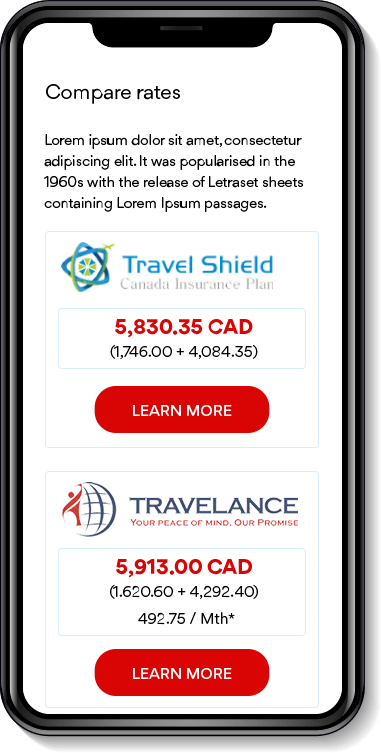- Connect with our licensed Canadian insurance advisors
- Shedule a Call
Registered Retirement Savings Plan (RRSP) Loan

Registered Retirement Savings Plan (RRSP) Loan
Today (Save Tax + Save Down Payment)
By Investing in RRSP with RRSP LOAN

Tomorrow (Enjoy Worry-Free Retirement)
Enjoy multiple Benefits of your Investments by Investing with RRSP Loan.
- Enjoy multiple Benefits of your Investments by Investing with RRSP Loan.
- No Income Proof, No Credit Check *
- Delay first payment for 120 Days
- Access to wide range of investment funds
- Repay the loan anytime
- *Limited time only.
- Save Taxes & Save for Down payment of your First Home!
- Save up to $500,000 to Millions of Dollars In RRSP.
Why Take Out An RRSP Loan?
- Get 0.5% Interest rate discount on RRSP Loan before feb. 11th
- You receive a higher tax break.
- You take advantage of unused contributions.
- You reach your savings objectives more quickly.
Can I Choose What I Invest In?
- Get 0.5% Interest rate discount on RRSP Loan before feb. 11th
- No Income Proof, No Credit Check *
- Delay first payment for 120 Days
- Access to wide range of investment funds
- Repay the loan anytime
The Advantages Of Taking Out An RRSP Loan With Us:
- A wide choice of investment funds.
- Monthly payments in line with your budget.
- Flexibility to repay your loan, in part or in full, at any time.
- Competitive interest rates.
Secure Your Retirement With An RRSP
Are you temporarily short on cash and are finding it difficult to contribute to your Registered Retirement Savings Plan (RRSP)? The best option is to take out an RRSP loan. As a matter of fact, the amount you receive from your tax investments and returns may even cover the loan cost. No matter your financial situation, you can make contributions to your Registered Retirement Savings Plan (RRSP) or even increase them, this way. Additionally, if you use your tax returns to pay your loan balance amount, you can end up repaying the loan amount more quickly. The best way to secure your retirement is to make a maximum contribution towards your Registered Retirement Savings Plan. But, in certain instances, you might find it difficult to find money, and this is where an RRSP loan is handy. For further information on the retro-activator RRSP loan, please do not hesitate to reach out to our expert team at Canadian L.I.C. We will be more than happy to address any queries that you may have.

Potential Savings With A Retro-Activator RRSP Loan
Any person who is looking to secure their retirement by reducing their tax should look to contribute to a Registered Retirement Savings Plan. Additionally, if the individual is under seventy-one years of age and earns a steady employment income can make contributions to an RRSP as well. The money invested in a Registered Retirement Savings Plan can be used to either purchase your dream home, make certain investments, or even go back to school, etc. If you have contributions that you have not used from your previous years, or you are looking to borrow a lump sum amount for this year’s contribution, taking a retro-activator RRSP loan from Canadian L.I.C will ensure that you do not miss out on the tax savings and the potential investment growth opportunities of an RRSP. With an RRSP contribution, the potential cost savings can outweigh the cost of borrowing. The money borrowed to be invested will grow in unison with the rest of your other RRSP investments, and they will be tax-free as long as they are still in your RRSP.
What Is An RRSP Loan?
As mentioned above, an RRSP is of the country’s most powerful tax-free investment accounts available to citizens and permanent residents of Canada. It is a savings tool that lets you save money over your lifetime by gradually lowering your tax bill. If you are running short of funds and are unable to contribute to your RRSP, then taking out an RRSP loan is the best available option. Whether you are considering maximizing this year’s contribution or making the most of the contribution that you have grown over the past couple of years, taking out an RRSP loan ensures you get more money growing tax-free towards your retirement goals. The tax refunds help you make the loan repayments much quicker. Below-mentioned is some of the reasons to contribute to an RRSP:
- The amount that one contributes to their RRSP is deducted from their taxable income, which grants the individual a tax refund.
- The interest that an individual will earn on their investments is not taxed as long as it stays in their Registered Retirement Savings Plan.
- The interest that an individual will earn on their investments is not taxed as long as it stays in their Registered Retirement Savings Plan.
The maximum amount one can borrow with a standard RRSP loan is up to $50,000, which is set by the Canada Revenue Agency. However, depending on your income, credit history and score, the bank will decide how much RRSP loan will be offered to the applicant. Usually, people will receive RRSP loan offers anywhere between $5,000 to $20,000.
Why Take Out An RRSP Loan From Canadian L.I.C?
- Higher tax return: When you take out an RRSP loan with Canadian L.I.C, you are guaranteed to receive a higher tax return. Our staff of highly qualified professionals will expertly educate and guide you on the benefits of choosing us for an RRSP loan.
- Carry forward your unused contributions: The contributions that you have not used in previous years or the current year, you can take advantage of these unused contributions and carry them forward to the following years subsequently.
- Reach your savings potential much more quickly: When you choose Canadian L.I.C to take out an RRSP loan, you can rest assured that your savings potential will be reached more quickly and efficiently. You can secure your retirement funds at the earliest and have peace of mind when you retire.
Are you short on cash? Don’t worry! You can still make contributions to your RRSP loan. Contact our friendly team today for further information on RRSP loans or to apply for one.
Benefits Of Investing In An RRSP Loan:
- No credit check is undertaken. You do not even have to submit any kind of income proof as well.
- You have the freedom to delay the first RRSP loan payment for about 120 days.
- You can make the loan repayment anytime at your convenience.
- You will have access to a comprehensive range of investment funds at your disposal
- If you are looking to purchase property, you can save on the down payment, including taxes
- With an RRSP, you can save up to $500,000 to millions of dollars
- You can get approved quickly if you have a decent credit history
- No fees are charged or applied when you change your payment dates or make a lump sum amount.
Want to know more about our RRSP loan offers? Reach out to Canadian L.I.C and speak to the experts today to get started on saving for your retirement.
The Advantages Of Taking Out An RRSP Loan With Canadian L.I.C:
- A complete range of investment funds.
- Monthly payments in line with your budget
- Flexibility to repay your loan, in part or in full, at any time
- Affordable interest rates
Here’s How An RRSP Loan Works
To make an RRSP contribution, you will need to borrow money. Over the period of the RRSP loan, you will need to regularly make principal and interest payments. A deduction on your tax return can be claimed for the amount you contribute. When you file your returns, the deduction may result in a claim for the deduction. If you receive a refund on the tax, you can use that amount to pay off your loan much more quickly simultaneously while your RRSP investments continue to grow. In the event your RRSP deduction reduces your taxes payable, this will free up some funds that can be used to pay your loan, to the government to reduce the non-tax-deductible interest that you will end up paying over the course of the repayment period.
How Long Would It Take To Pay Back An RRSP Loan?
You will have around twelve months to pay back the Registered Retirement Savings Plan (RRSP) loan. However, most RRSP loans are open-ended, which means you can pay them off sooner. One of the most ideal ways to pay back an RRSP loan is to use the income tax refund you receive from your RRSP contributions.

Things To Keep In Mind Before Getting An RRSP Loan
Below-mentioned is some of the factors that need to be considered:
- Your taxable income: If you are in a lower tax bracket because of your income, there is a significantly lower chance of you making a large RRSP contribution. You can use the RRSP deduction in the year if you are at a higher tax rate to reduce your income and also provide you with greater tax savings.
- Ability to pay back the loan: If you are not able to pay the loan amount within a year, it does not make a lot of sense to add more to your existing debt load. If you are considering using your tax refund to pay off the loan, you have to ensure that you are very careful when applying for the refund on the loan.
- The level of debt you are currently in: If you are paying high-interest credit card debts, your focus should be on paying the debt as quickly as possible. Ensure that you are not going to get into much further debt.
- Rate of interest: Choosing to borrow money when the interest rate is high can prove to be very costly. The charges can add up and cancel out the initial benefit of making the Registered Retirement Savings Plan contribution. The interest on the money borrowed to make an RRSP contribution is not tax-free. You have to make sure that your return on investment is greater than the borrowing costs. If your interest rate is fixed or variable, your costs on borrowing can increase or decrease.
Who Should Take An RRSP Loan?
Registered Retirement Savings Plan (RRSP) loans are best suited for individuals who earn a high income with a tax rate greater than 30%. The higher your income and the more taxes you pay, the more beneficial it can be for you to take out an RRSP loan. Borrowers whose tax rates are over 30% gain the most from RRSP contributions, as they reduce their income tax burden, including their income, by paying off the loan. If you earn an income less than $100,000 annually, or your tax rate is less than 30%, it is unlikely that you will stand to benefit from an RESP loan. It is highly advised that you wait a little longer than your income or tax bill has increased.
Apply For An RRSP Loan With Canadian L.I.C Today!
A Registered Retirement Savings Plan allows you to stick to your plan and not miss your contribution deadline, including taking advantage of a higher than normal tax benefit. This results in instant tax savings and increases the long-term growth of your RRSP. If you are able to repay your RRSP loan within a short time frame, and you don’t plan on retiring in the near future, an RRSP loan is a perfect solution to achieve your retirement goals. You must bear in mind that taking out a loan to contribute to your RRSP comes with certain costs and risks. Consult an expert advisor from Canadian L.I.C to help you decide whether or not opening an RRSP is the right choice for you.
Get The Best Insurance Quote From Canadian L.I.C

Mrs. Harpreet Puri is always friendly and professional and answers all of our questions with infinite patience. Helped us a lot in our health insurance. She is the best advisor.

Lalit Kumar
Ceo & Founder
Wonderful personality and very professional lady . Best knowledge of all the product and I m so happy with her service. Thankyou

Maninder Bihla
Designer
Wonderful Personality. She has a good knowledge of insurance and also gives you variety of options to work with your budget. I will recommend her for your insurance needs.

Karam Sandhu
Store Owner
Mrs. Harpreet Puri is always friendly and professional and answers all of our questions with infinite patience. Helped us a lot in our health insurance. She is the best advisor.

Lalit Kumar
Ceo & Founder
Wonderful personality and very professional lady . Best knowledge of all the product and I m so happy with her service. Thankyou

Maninder Bihla
Designer
Wonderful Personality. She has a good knowledge of insurance and also gives you variety of options to work with your budget. I will recommend her for your insurance needs.

Karam Sandhu
Store Owner
Mrs. Harpreet Puri is always friendly and professional and answers all of our questions with infinite patience. Helped us a lot in our health insurance. She is the best advisor.

Lalit Kumar
Ceo & Founder
Wonderful personality and very professional lady . Best knowledge of all the product and I m so happy with her service. Thankyou

Maninder Bihla
Designer
Wonderful Personality. She has a good knowledge of insurance and also gives you variety of options to work with your budget. I will recommend her for your insurance needs.

Karam Sandhu
Store Owner
FAQ
Sign-in to CanadianLIC
Verify OTP





























